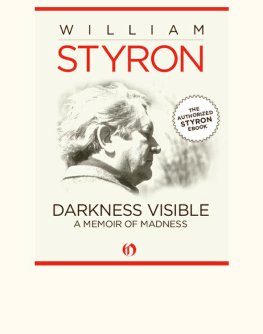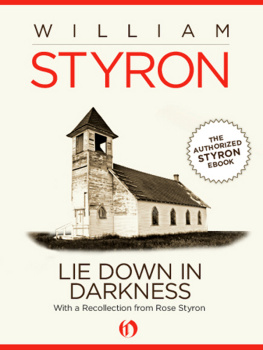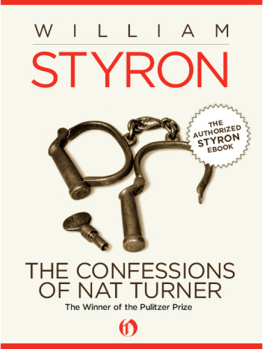William Styron, A Life
James L. W. West III

For my sons
JAMES THOMAS WILLIAM
And I gave my heart to know wisdom,
and to know madness and folly:
I perceived that this also
is vexation of spirit.
For in much wisdom is much grief:
and he that increaseth knowledge
increaseth sorrow.
ECCLESIASTES 1:1718
CONTENTS
I began this biography in 1985 and published it in 1998. The work, from beginning to end, was pleasurable and purposeful. Much writing by academics, including some writing that I have published, attracts a small audience and has a short shelf life. A learned friend of mine used to say that the last person who read most of what he had published was very likely the man who set the type. This biography, I trust, will have a longer life span and a broader readership than that.
When I began this project, I could not have conceived of the ebook, a method of literary production that will now make the story of William Styrons life available to millions of readers in digital form. Its second nature to think of such texts todayand even of writing books that are meant to exist only in virtual form. I composed this biography using traditional practices. I wrote in longhand, sitting in a basement room with only my cat for company. I used black rollerball pens and wrote always on white lined pads. There was a tactile feeling to the work: I inscribed the words quickly, sometimes in a kind of shorthand, then revised so thoroughly that the handwritten sheets, which I still possess, have a comfortably messy look. Next, I typed the chapters into an old computer which, as I recall, did not have a mouse (you moved the cursor around with the up-and-down and side-to-side buttons). Then came the printer, a little workhorse that had an idiosyncrasy: it would print one page, then spit out a blank, then print the next page, then fire another blank, and so on to the end of the file. I would separate the blank sheets from the printed ones, insert the blanks back into the paper tray, and forge on.
Midway through the compositional process, at the end of (just after Styron has published Set This House on Fire), I thought of making this biography into a double-decker, a two-volume treatment. I could publish the first half, then finish the rest as time and inclination allowed. Today I am glad I abandoned that notion and pushed through to the end. I have heard since of too many biographers who postponed publication until very late in their lives. As a result they had only a few years in which to see their work incarnate or, worse, never finished their books at all.
It would have pleased William Styron to know that his works are available from Open Road. His writings will now reach readers through digital technology, ever evolving, enhanced by photographs and moving images and commentary from those who knew him. When Styron published Lie Down in Darkness in 1951, he was working in a print marketplace that had not changed in its essentials since the 1880s. As he moved through his career, however, he saw dramatic changes in the ways in which books were produced and sold. He would not have been surprised by further developments. Lie Down in Darkness, Set This House on Fire, and The Confessions of Nat Turner were typeset in hot metal and printed on relief presses; Sophies Choice, Darkness Visible, and A Tidewater Morning were set on computers and printed by photo-offset. Paperbacks changed from a sideshow to a powerful force in the publishing world during the 1960s; they played a major role in creating the readership of Nat Turner. Chain bookstores entered in the 1970s and brought Sophies Choice to thousands of readers. Audiobooks came soon thereafter and made Darkness Visible available for listening instead of reading. Styron was open to any form of publication that would reach the people who wanted to know what he had to say. He was never a coterie writer; he aimed to have numerous readers and achieved that goal, with three books that reached the top of the New York Times bestseller list and with sales, worldwide, in the millions. He too was a traditional worker: He composed in pencil on long yellow pads and was only a hunt-and-peck typist, but he understood that his words and thoughts could be transmogrified by new technologies without losing their force or meaning.
I miss working on this biography. Other projects now occupy me, but none has been as satisfying as this one. The structuring of narrative, the blending of voices, the marshalling of facts, the interweaving of strands of evidenceall of this was exciting for me, quickening to the intellect. I am glad that I published this book when I did, while Styron was alive and could hold it in his hand. I am equally glad that this biography will continue to live in the digital world and will now find a new generation of readers.
J. L.W.W. III
15 June 2010
If one wishes to know William Styron, one must walk with him. That is to say, one must go with him on his daily walk for exercise. It is a ritual that he rarely misses; usually he takes the walk alone, though sometimes he goes with his wife or a friend or visitor. The walk covers between four and five miles unless the weather is bad, in which case it is abbreviated.
Preparations for the walk begin around three oclock with the calling of the dogs. There are two dogs just now, both femalesa golden retriever named Tashmoo and a black Labrador named Dinah. Tashmoo is sweet-tempered and shy; Dinah is brash and adventurous. Styron is devoted to them both but is especially fond of Dinah, who amuses and exasperates him. He summons the dogs by hooting at them: Baby! Hooo! Come to Daddy! Hooo! Come on! The dogs, attuned to the schedule, are ready. Dinah appears, dirty and panting; Tashmoo, who has been resting, trots over to Styron and waits. An old coat is spread over the backseat of the car, and the dogs jump in. Styron and his guest settle into the front seats; Styron starts the engine and puts the car into motion.
Styron almost always drives to the beginning point of a walk. He has explored and measured off many walking paths near his two homes, and he rarely takes the same walk two days in a row. The paths themselves are far from automobile traffic, but one must drive through traffic to reach them. Styron operates the car skillfully; he drives impatiently and a little too fast. On the way he announces the location and direction of our walk for the day, then talks baby talk to Dinah, who licks the back of his head and bites his ears while he is driving.
Styron arrives at the starting point, sets the dogs loose, and begins the walk. He takes the first half-mile at a relaxed amble, to loosen the muscles; then he settles into a steady pace that accelerates the heartbeat and gives the lungs a workout. Though seventy-two years old, Styron can outwalk many men twenty or thirty years his junior. He walks with a spraddle-legged gait, slightly slew-footed, and leans forward from the waist. The exercise is good for his bronchial troubles; he clears his throat and blows his nose frequently on these walks, especially during the winter.
The conversation on the walks is good. Sometimes Styron talks about something he has been readingan editorial from The New York Times, perhaps, or a memoir written by a friend. At other times he mentions critics of his own work, clearing his throat and spitting out the names of unsympathetic book reviewers with great vehemence. Sometimes he discusses politics; during the Reagan and Bush administrations he would do wonderfully profane riffs on the Republicans, venting his irritations over their dastardly behavior. Styron does most of the talking during these walks. It is satisfying to listen, for he is a good talker.
Next page








